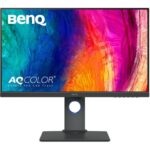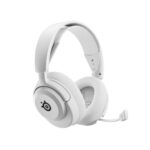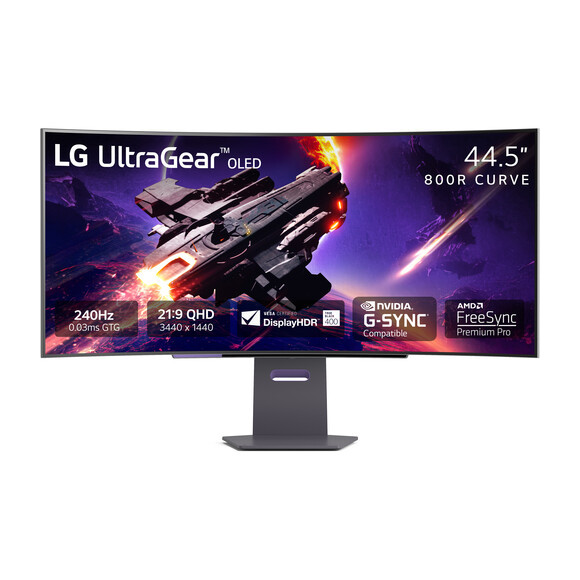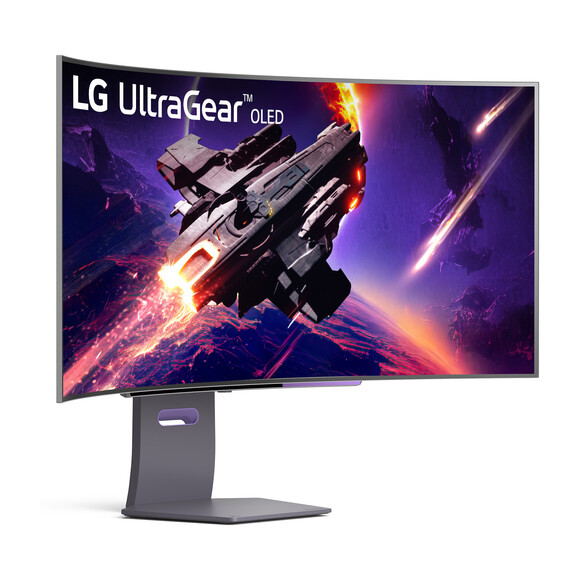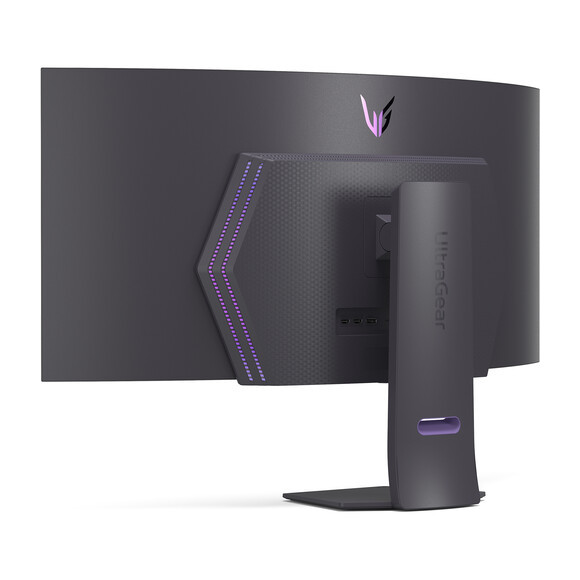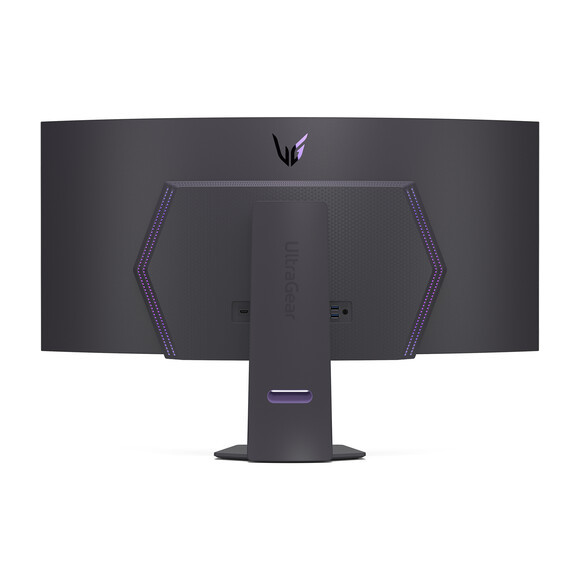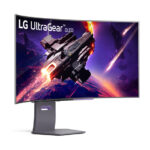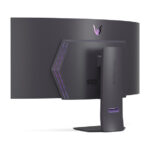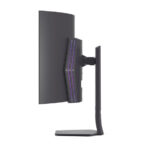LG 45″ UltraGear 45GS95QE-B 1440p 240Hz OLED Curved FreeSync Premium Pro Gaming Monitor Price in Pakistan
| Brand
Name of the company-manufacturer. |
LG |
| Series
Name of the series, which the model belongs to. |
UltraGear |
| Model
Designation of the model. |
45GS95QE |
| Model alias
Other known designations of the model. |
UltraGear 45GS95QE 45GS95 45GS950B 45GS950X 45GS95X |
| Model year
The year in which this model was announced. |
2024 |
Display
Information about the main characteristics of the display – panel, backlight, resolution, refresh rate, etc.
| Size class
Size class of the display as declared by the manufacturer. Often this is the rounded value of the actual size of the diagonal in inches. |
44.5 in (inches) |
| Diagonal
Approximate diagonal size of the display. If the manufacturer does not provide such information, the diagonal is calculated from the width and height of the screen. |
1130 mm (millimeters) 113 cm (centimeters) 44.4882 in (inches) 3.7073 ft (feet) |
| Width
Approximate width of the display. If the manufacturer does not provide such information, the width is calculated from the diagonal and the aspect ratio. |
1042.66 mm (millimeters) 104.266 cm (centimeters) 41.0496 in (inches) 3.4208 ft (feet) |
| Height
Approximate height of the display. If the manufacturer does not provide such information, the height is calculated from the diagonal and the aspect ratio. |
436.46 mm (millimeters) 43.646 cm (centimeters) 17.1835 in (inches) 1.432 ft (feet) |
| Radius of curvature
There are curved displays, whose curve is part of a circumference (arc). In order to give more precise information about the curve of the screen, often the manufacturer provides data about the radius of this circumference. The smaller the radius, the larger the screen curve. |
800 mm (millimeters) 80 cm (centimeters) 31.4961 in (inches) 2.6247 ft (feet) |
| Panel manufacturer
Name of the manufacturer of the display panel. |
LG Display |
| Panel type
There are various panel technologies. Each has its own specific features – viewing angles, color reproduction, response time, brightness/contrast, production cost, etc. The image quality depends directly on the type of the display panel used. |
OLED |
| Panel bit depth
The most widely used panels are those with 6, 8, and 10 bits for each of the RGB components of the pixel. They provide 18-, 24-, and 30-bit color, respectively. |
10 bits |
| FRC
Frame Rate Control (FRC) is a method, which allows the pixels to show more color tones. With quick cyclic switching between different color tones, an illusion for a new intermediate color tone is created. For example, by using FRC, a 6-bit display panel is able to show 16.7 millioin colors, which are typical for 8-bit display panels, and not the standard 262200 colors, instead. There are different FRC algorithms. |
No |
| Colors
The maximum number of colors, which the display is able to reproduce, depends on the type of the panel in use and color enhancing technologies like FRC. |
1073741824 colors 30 bits |
| Aspect ratio
The ratio between the horizontal and the vertical side of the display. Some of the standard and widely used aspect ratios are 4:3, 5:4, 16:9 and 16:10. |
2.389:1 |
| Resolution
Information about the number of pixels on the horizontal and vertical side of the screen. A higher resolution allows the display of a more detailed and of higher quality image. |
3440 x 1440 pixels |
| Pixel pitch
The pixel pitch shows the distance from the centers of two neighboring pixels. In displays, which have a native resolution (the TFT ones, for example), the pixel pitch depends on the resolution and the size of the screen. |
0.303 mm (millimeters) 0.0303 cm (centimeters) 0.0119 in (inches) 0.001 ft (feet) |
| Pixel density
Information of the number of pixels in a unit of length. With the decrease of the display size and the increase of its resolution, the pixel density increases. |
83 ppi (pixels per inch) 32 ppcm (pixels per centimeter) |
| DCI P3
DCI P3 is a color space, introduced in 2007 by the SMPTE. It is used in digital cinema and has a much wider gamut than the sRGB. |
98.5 % (percent) |
| Brightness
Information about the brightness of the screen. It is measured in candela per square metre (cd/m²). |
275 cd/m² (candela per square meter) |
| Static contrast
The static contrast shows the ratio between the brightest and the darkest color, which the display can reproduce simultaneously, for example, within one and the same frame/scene. |
1500000 : 1 |
| HDR
HDR expands the contrast ratio (peak luminance and minimal black levels) and color palette to achieve more details across the whole image – from the darkest parts to the brightest ones, which results in more realistic and life-like image. |
HDR10 DisplayHDR 400 True Black |
| Horizontal viewing angle
Information about the maximum horizontal viewing angle, within which the image on the screen is of acceptable quality. |
178 ° (degrees) |
| Vertical viewing angle
Information about the maximum vertical viewing angle, within which the image on the screen is of acceptable quality. |
178 ° (degrees) |
| Minimum response time
Information about the minimum amount of time, in which the pixels change from one color to another. Very often the manufacturer provides the response time for transition from grey-to-grey (G2G). |
0.03 ms (milliseconds) 0.0000 s (seconds) |
| Coating
Information about the type of coating of the display. There are different types of matte and glossy coatings, each of which has its own advantages and drawbacks. |
Anti-glare/Matte |
| AGLR – anti-glare low reflection coating |
3D
3D displays use various technologies to achieve a 3D effect. Each of these technologies has its own advantages and drawbacks.
| 3D
Information on whether 3D is supported or not. |
No |
Frequencies
Information about the horizontal and vertical refresh rates/frequencies.
| Vertical frequency (digital)
The vertical frequency/refresh rate shows how many times in a second the image on the screen is refreshed. |
48 Hz – 240 Hz (hertz) |
Power supply and consumption
Information about the power supply and consumption, energy efficiency class, etc.
| 110V
Permissible voltage tolerance in a 110-volt electric system. |
100 V – 120 V (volts) |
| 220V
Permissible voltage tolerance in a 220-volt electric system. |
220 V – 240 V (volts) |
| Alternating current frequency
Requirement regarding the alternating current frequency in the electric system. |
50 Hz – 60 Hz (hertz) |
| Power consumption (off)
Power consumption in off-mode. |
0.3 W (watts) |
| Power consumption (sleep)
Power consumption in sleep/stand by/suspend mode. |
0.5 W (watts) |
Dimensions, weight and color
Information about the dimensions and the weight of the specific model with and without stand as well as the colors, in which it is offered to the market.
| Colors
Information about the colors, in which the specific model is offered to the market. |
Black |
Ergonomics
Information about the ergonomic functions – height adjustment, swivel angles, tilt angles, etc.
| VESA mount
Information about whether there is a possibility for wall mounting according to the VESA Mounting Interface Standard (MIS). |
Yes |
| VESA interface
There are many various interfaces under the VESA standard, which differ in the size of the brackets, the distances between the screw holes and their number. |
100 x 100 mm |
| Removable stand
Information about whether the stand can be dismounted. Usually, this is required for wall mounting. |
Yes |
| Height adjustment
Information about whether the stand allows height adjustment. |
Yes |
| Landscape/portrait pivot
Some displays have the ability to operate in landscape and portrait mode alike. |
No |
| Left/right swivel
Information whether the display can be swiveled around the stand axis. |
Yes |
| Left swivel
Maximum swivel degree of the display to the left of the stand axis. |
10 ° (degrees) |
| Right swivel
Maximum swivel degree of the display to the right of the stand axis. |
10 ° (degrees) |
| Forward/backward tilt
Most displays have the ability to be tilted forward and backward as to provide a more comfortable viewing position for the user. |
Yes |
Camera
Many contemporary desktop monitors and smart TV sets have built-in cameras.
| Camera
Information whether the current model has a built-in camera or not. |
No |
Connectivity
Available connectivity ports, slots and interfaces.
| Connectivity
Information about the available connectivity ports, slots and interfaces such as USB, infrared port, SD card slot, audio/video and network interfaces, etc. |
1 x USB 3.2 (Type-B; upstream) 2 x USB 3.2 (Type-A; downstream) 2 x HDMI 2.1 1 x DisplayPort 1.4 (DSC) 1 x 3.5 mm Audio Out (4-pole; DTS Headphone:X) |
Features
Some additional functional features of the model.
| Features
Information about additional software features, technologies, functions and services of the model. |
4-Side Virtually Borderless Design AMD FreeSync Premium Pro Auto Input Switch Black Stabilizer Color Calibrated Color Weakness Mode Crosshair Display Stream Compression (DSC) Dual Controller Dynamic Action Sync FPS Counter Factory Calibration HDR Effect NVIDIA G-Sync Compatible Picture-by-Picture Picture-in-Picture Picture Mode Reader Mode RGB Hexagon LED Lighting Smart Energy Saving True Color Pro User Define Key |
Operating and storage conditions
There are certain requirements for the environmental conditions, in which the display should be used and stored in order to function properly.
| Operating temperature
The operating temperature shows the safe temperature range (from minimum to maximum), within which the display will function flawlessly. Outside this range it might operate improperly and/or fail entirely. |
0 °C – 40 °C (degrees Celsius) 32 °F – 104 °F (degrees Fahrenheit) |
| Operating humidity
The operating humidity shows the acceptable level of humidity, in which the display will function flawlessly. It sets a lower and an upper humidity level for safe operation and is measured in percentage. |
10 % – 80 % (percent) |
| Storage temperature
The storage temperature shows the range from a minimum to a maximum temperature, within which storing of the display is considered to be safe. |
-20 °C – 60 °C (degrees Celsius) -4 °F – 140 °F (degrees Fahrenheit) |
| Storage humidity
The storage humidity shows the lower and upper humidity limit, which ensures safe storage of the display. Storing it outside these limits might damage the display. |
5 % – 85 % (percent) |
Accessories
Often the packaging of desktop monitors and smart TV sets includes accessories for them.
| Accessories
Information about some of the main accessories included in the standard packaging of the current model. |
DisplayPort cable HDMI cable Remote control |

 DRLR & Mirrorless
DRLR & Mirrorless Camera Lenses
Camera Lenses UV Filters
UV Filters Action Cameras
Action Cameras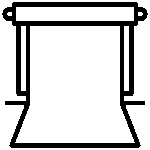 Backdrop & Support Kit
Backdrop & Support Kit Battery & Charger
Battery & Charger Camera Bags
Camera Bags
